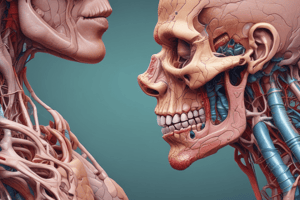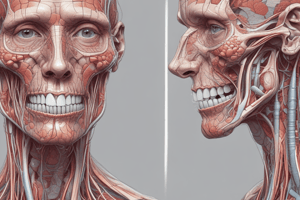Podcast
Questions and Answers
What is the typical pH range of saliva?
What is the typical pH range of saliva?
- 6.7 - 7.4 (correct)
- 7.5 - 8.0
- 7.0 - 8.5
- 5.0 - 6.0
Which protein in saliva is primarily responsible for aiding in the disposal of bacteria?
Which protein in saliva is primarily responsible for aiding in the disposal of bacteria?
- Mucin
- Immunoglobulins (correct)
- Amylase
- Lactoferrin
What is the role of lysozyme in saliva?
What is the role of lysozyme in saliva?
- Inhibits bacterial metabolism
- Destroys harmful bacteria by lysis (correct)
- Breaks down starches
- Neutralizes acids
Which enzyme catalyzes the endonucleolytic cleavage of RNA?
Which enzyme catalyzes the endonucleolytic cleavage of RNA?
How do mucin proteins affect the consistency of saliva?
How do mucin proteins affect the consistency of saliva?
What by-product of cell metabolism can neutralize acids found in saliva?
What by-product of cell metabolism can neutralize acids found in saliva?
Which component of saliva helps reduce the acidity that contributes to tooth decay?
Which component of saliva helps reduce the acidity that contributes to tooth decay?
Which of the following statements about saliva's protein content is true?
Which of the following statements about saliva's protein content is true?
What triggers increased salivary flow during mastication?
What triggers increased salivary flow during mastication?
Which condition is most likely to reduce salivary flow due to its effects on the nervous system?
Which condition is most likely to reduce salivary flow due to its effects on the nervous system?
How does hunger increase salivary flow?
How does hunger increase salivary flow?
What is the primary effect of alcohol on salivary production?
What is the primary effect of alcohol on salivary production?
Which of the following conditions is associated with decreased salivary flow due to dehydration from high blood sugar levels?
Which of the following conditions is associated with decreased salivary flow due to dehydration from high blood sugar levels?
What physiological response occurs during teething to increase saliva production?
What physiological response occurs during teething to increase saliva production?
What effect does fear have on salivary flow?
What effect does fear have on salivary flow?
Radiotherapy can affect saliva production by damaging which type of glands?
Radiotherapy can affect saliva production by damaging which type of glands?
What role does salivary amylase play in digestion?
What role does salivary amylase play in digestion?
How may xerostomia affect taste sensation?
How may xerostomia affect taste sensation?
Which of the following describes the protective function of saliva?
Which of the following describes the protective function of saliva?
What impact does the salivary pellicle have on teeth?
What impact does the salivary pellicle have on teeth?
What changes in saliva quantity are observed from day to night?
What changes in saliva quantity are observed from day to night?
What is the immediate effect of a fall in pH in the mouth?
What is the immediate effect of a fall in pH in the mouth?
How does saliva help manage acid in the mouth?
How does saliva help manage acid in the mouth?
What may happen to patients with impaired salivary flow?
What may happen to patients with impaired salivary flow?
What happens to mineral ions when the pH falls below 5.5?
What happens to mineral ions when the pH falls below 5.5?
Which mechanism stimulates saliva flow in response to sensory inputs?
Which mechanism stimulates saliva flow in response to sensory inputs?
What is the effect of sympathetic stimulation on salivary flow?
What is the effect of sympathetic stimulation on salivary flow?
How does parasympathetic stimulation affect the salivary glands?
How does parasympathetic stimulation affect the salivary glands?
What occurs when the buffering action is effective and pH rises in the plaque fluid?
What occurs when the buffering action is effective and pH rises in the plaque fluid?
At what pH level does the solubility limit for plaque fluid begin to affect calcium and phosphate ion concentrations?
At what pH level does the solubility limit for plaque fluid begin to affect calcium and phosphate ion concentrations?
What type of nerve actions control the salivary glands?
What type of nerve actions control the salivary glands?
What is the primary effect of salivation in response to favorable sensory stimuli?
What is the primary effect of salivation in response to favorable sensory stimuli?
What is the pathway for the parasympathetic supply to the submandibular and sublingual glands?
What is the pathway for the parasympathetic supply to the submandibular and sublingual glands?
Which nerve carries taste sensation from the posterior third of the tongue?
Which nerve carries taste sensation from the posterior third of the tongue?
Which structure is the postganglionic pathway of the parasympathetic supply to the parotid gland associated with?
Which structure is the postganglionic pathway of the parasympathetic supply to the parotid gland associated with?
What type of nerve supply increases saliva production in the submandibular and sublingual glands?
What type of nerve supply increases saliva production in the submandibular and sublingual glands?
Which ganglion is involved in the synapse for the parasympathetic supply to the parotid gland?
Which ganglion is involved in the synapse for the parasympathetic supply to the parotid gland?
Which nerve does taste information from the anterior two-thirds of the tongue travel with to the nucleus solitarius?
Which nerve does taste information from the anterior two-thirds of the tongue travel with to the nucleus solitarius?
What is the source of sympathetic supply to the submandibular and sublingual glands?
What is the source of sympathetic supply to the submandibular and sublingual glands?
Which of the following factors is likely to cause an increase in salivary flow?
Which of the following factors is likely to cause an increase in salivary flow?
Flashcards are hidden until you start studying
Study Notes
Salivary Flow
- Increased flow
- Mastication - mechanical stimulation of the salivary glands
- Irritants - triggers the salivary glands to fight infection
- Gingival conditions - triggers the salivary glands to promote healing
- Hunger - brain anticipates food and stimulates the salivary glands
- Smell/sight of food - brain anticipates food and stimulates the salivary glands
- Teething in babies - more saliva is created to soothe irritated gums
- Reduced flow
- Drugs - interfere with the nervous system that regulates saliva flow
- Alcohol - dehydrates the body
- Diabetes - dehydration and high blood sugar levels cause saliva gland hypofunction
- Fear - the nervous system is affected
- Radiotherapy - damage to the saliva glands
- Surgery - anesthesia used suppresses the nervous system
pH of Saliva
- Average pH is 6.7-7.4, which is neutral
- pH can vary depending on what has been eaten and the time of day
- Low pH leads to higher caries
- High pH leads to more calculus formation
Components of Saliva
- Proteins:
- Various proteins with antibacterial properties
- Mucin and enzymes are also proteins
- Immunoglobulins:
- IgA, IgG and IgM
- Destroy bacteria by clumping them, preventing adherence to the oral cavity
- Enzymes:
- Lysozyme - destroys bacteria by lysis (cell wall destruction)
- Lactoferrin - binds free iron, inhibiting bacterial metabolism
- Lactoperoxidase - also inhibits bacterial metabolism
- Amylase - begins the breakdown of cooked starches
- Ribonuclease - cleaves RNA
- Phosphatase - involved in the process of calculus formation and remineralisation of caries
- Mucin:
- Gives saliva its viscous consistency
- Two types:
- Muco-proteins - contain more than 4% carbohydrate derivatives
- Glyco-proteins - contain less than 4% carbohydrate derivatives
- Waste products:
- Urea - neutralizes acids
- Uric acid
- Ammonia - formed from urea; raises pH
- All are by-products of cell metabolism
Other components of Saliva
- Cells:
- Desquamated epithelial cells - worn/dead cells are replaced
- White blood cells - from the gingival crevice, especially during inflammation
- Digestion:
- Salivary amylase breaks down cooked starches and helps to form the bolus
- Taste:
- Taste sensation can only be detected when substances are in solution
Functions of Saliva
- Antimicrobial:
- Proteins and Immunoglobulins help destroy or prevent colonization by harmful bacteria
- Tooth integrity:
- Ions in saliva aid maturation of immature enamel and aid repair from acid attacks
Saliva and Caries
- Viscosity:
- The salivary pellicle, formed by glyco-proteins, protects against acids but also encourages adherence by bacteria
- Supersaturation of Inorganic Ions:
- Acts as a buffer to control acid in solution and continually aids control of demineralization and remineralization
- Serous Saliva:
- Cleansing action reduces the amount of fermentable carbohydrate available for conversion to acid
- Quantity:
- Changes from day to night
- Stimulated by eating
- Affected by drugs, illness and radiation
pH Fluctuations
- The salivary buffering system can reduce the extent of the fall in pH when sugars enter the mouth
- Prolonged episodes can exhaust the system's ability to contain ion removal
- A fall in pH below 6.0 increases:
- The free energy of the ions at the enamel/plaque interface
- The migration of ions from both enamel and plaque
Demineralization and Remineralization
- When the solubility limit of the plaque fluid exceeds the calcium and phosphate ion products, these ions leave the enamel
- This occurs at around pH 5.5
- Below this level, enamel begins to demineralize
- If the buffering action is effective and the pH rises, the additional mineral ions in the plaque fluid will exceed its capacity to hold them in solution. This will cause the mineral ions to return to the enamel, and the enamel will remineralize.
Mechanism of Salivation
- Salivation is a reflex mechanism stimulated by sensory inputs:
- Sight
- Smell
- Taste
- Also controlled by the sympathetic and parasympathetic nervous systems:
- Sympathetic: Reduces salivary flow
- Parasympathetic: Increases salivary flow
Salivary Gland Innervation
- The sympathetic and parasympathetic nerves have opposite effects on the salivary glands.
- Sympathetic:
- Reduces flow via vasoconstriction
- Parasympathetic:
- Increases flow via vasodilation
Glands and Innervations
- Hard and Soft Palate:
- Sympathetic: From the internal carotid artery to the sphenopalatine ganglion
- Parasympathetic: From the superior salivary nucleus via the facial nerve to the sphenopalatine ganglion
- Submandibular and Sublingual Glands:
- Sympathetic: From the facial artery via the submandibular ganglion to the sublingual and submandibular glands
- Parasympathetic: From the superior salivary nucleus via the facial nerve to the submandibular ganglion.
- Parotid Glands:
- Sympathetic: From the middle meningeal artery via the otic ganglion to the parotid
- Parasympathetic: From the inferior salivary nucleus via the glossopharyngeal nerve to the otic ganglion
Taste
- The anterior two-thirds of the tongue:
- Taste buds via the lingual nerve to the submandibular ganglion
- Then travel with the chorda tympani and the facial nerve to the nucleus solitarius in the brain.
- The posterior third of the tongue:
- Taste buds via the glossopharyngeal nerve to the nucleus solitarius in the brain
Studying That Suits You
Use AI to generate personalized quizzes and flashcards to suit your learning preferences.




